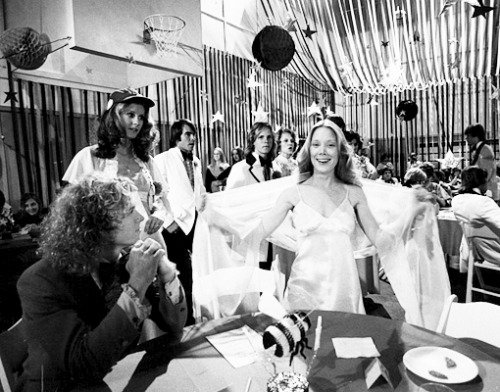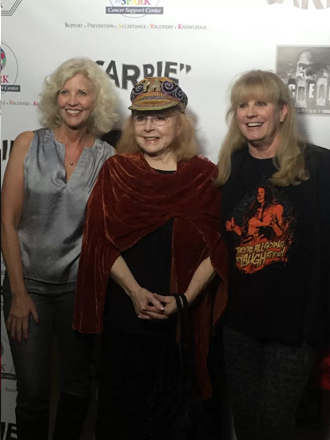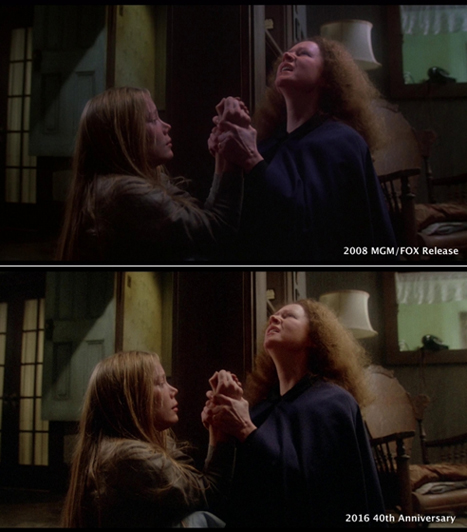VIDEO - 'CARRIE' 40TH ON-STAGE DISCUSSION
PAUL HIRSCH: "FIRST TIME I'VE SEEN THE FILM IN 40 YEARS"Thanks to Alex for sending along the link to the above video, which shows the on-stage discussion that took place following the 40th anniversary screening of
Carrie two weeks ago. The Q&A was moderated by
Bryan Fuller, on stage with
Piper Laurie, Nancy Allen, P.J. Soles, Doug Cox, Terry Bolo, and
Paul Hirsch. Below are some transcripted moments from the video:
PAUL HIRSCH: "I WAS STRUCK BY HOW INTERESTINGLY EVERY SCENE WAS SHOT"Hirsch: Honestly, Brian would bring me his storyboards that he had drawn himself. They’re not like storyboards as we know them today. So then he would show me these drawings he’d made, and I couldn’t make head or tail of them. [laughter] And I said [nodding], “That looks great, Brian. That looks great.” [more laughter] And then, I would just react to the footage. But, you know, watching the film tonight, the first time I’ve seen it in 40 years [“wow” reaction from the audience]… ‘cause, you know, when you get to the end of a film, and you’ve seen it so many times, you never want to see it again [laughter], which is the Faustian bargain that editors make. But watching it tonight, I was struck by how interestingly every scene was shot: the angles, the lighting. And nothing was done conventionally. Every choice was very interesting, with a point, and an attitude. And I thought the scenes between Nancy and John were so rich in chemistry, and you could really feel the feeling between them—the dance of the eyes, as they say. And then the scenes between Piper and Sissy were like operatic duets. They were just fabulous. I just had a great time watching the picture tonight.
NANCY ALLEN ON THE FILM'S STRANGE RELATIONSHIP BETWEEN CHRIS & BILLY
Fuller: Speaking of Nancy and John Travolta, you have such a strange relationship with him in this film, as in other films, and it has this BDSM sort of quality to it. So, you were kind of John Travolta’s first cinematic dom.
Allen: And I’m proud of it. [laughter]
Fuller: Can you talk a little bit about filming that scene? Because it’s interesting to watch it with a modern audience, where he’s slapping you, you slap him, you have this very physically-abusive relationship, and on screen, then you look at your chemistry in Blow Out, which is so dynamic… What was it like, doing those two different [audience applauding] – Blow Out, people, I mean, let’s come on. [applause] Also edited by Paul Hirsch.
Allen: Well, first of all, John and I had a ball in the movie, and we really did have tremendous chemistry together. He’s a lot of fun to work with. He’s a very funny guy. But, the scene in the car, as you know, I was slapped earlier by Betty Buckley, and she was really slapping me, a lot, and John was so sweet. I mean, he would [touching her hand to her face repeatedly] barely touch me with his hands. And the fact that I was so bitchy with him—in the original storyboards, when Brian showed me, before we shot the film, he was supposed to rip my shirt off in the scene in the car. And he said, [waving her hand] “Yeah, that would not work with her. We’re not going to shoot that. She’ll kill him if he does that.” So, you know, we also thought that we were the comic relief in the movie. We had no idea everyone was going to hate us, because the crew laughed at us so much. So, we had a great time on that, and when we came together in Blow Out, it was so very different. He had had tremendous success in Saturday Night Fever and Grease, and I hadn’t seen him in a long time, and I had no idea if he had changed, or what he was going to be like. But when he walked in for rehearsals, he said, “Hey, let’s order a pizza.” We ordered pizza, we started working, and started to do some improvisation together to make the script work for us, because it was very, very different. And to me it was always magical working with him, because you never knew what he was going to do.
PAUL HIRSCH DISCUSSES THE FAST-FORWARD USED IN THE TUXEDO SHOP SCENE
Fuller: Now, Mr. Hirsch, in the middle of that tuxedo shop scene, you just fast-forwarded for a while. Were you just like, “Let’s get this moving along,” or… what sort of choice was that?
Hirsch: Well, it was an interesting problem, because the scene was constructed on jump cuts, and the middle segment was too long. And I didn’t want to throw in another jump cut, because the jump cuts were… I was saving them for more significant moments.
Fuller: Like when you blow up a car…
Hirsch: No, no, no, I mean like in that scene, there were two very definite time cuts. I didn’t want to throw another one in the middle of one of the scenes. The three little scenes. So I had seen this film directed by Agnès Varda, and edited by a friend of mine, Robert Dalva. [note: Dalva also later worked on editing De Palma’s Raising Cain, as did Hirsch.] And he had done that. They had this long scene, I remember two characters on the bed, and they just sped-up—like the boring parts—they just sped-up. And I thought, well, that’s a great way to shorten the scene, so I thought I’d try it. And then, I think Pauline Kael called it “a stupid editor trick,” or something, you know. [laughter]
Fuller: Oh, Pauline.
Hirsch: You win some, you lose some. But it worked to preserve the pace of the scene, and not have to throw in a jump cut where I didn’t want one.
P.J. SOLES ASKS PAUL HIRSCH ABOUT THE USE OF SPLIT SCREEN IN 'CARRIE'
Later on, P.J. Soles asks Hirsch how the split screen was decided on for Carrie’s rage at the prom. Hirsch explains that split screen is “a passion of Brian’s,” and how he had used it initially for Dionysus In ’69. “And he was always fascinated by split screen,” Hirsch explains, “because he thought, well, it expands your perception of what’s going on.”
Hirsch then continues, “There are certain situations where it works very well. It’s not ideally suited for an action sequence because the fact that you’re looking at a split screen is a distancing device that keeps you from identifying with the characters the way you would when the image is full screen. It’s an intellectual fascination as opposed to an emotional connection.”
 Piper Laurie will be on hand at the Orinda Theatre in Orinda, California this Saturday, January 14th, for a double feature of two of her greatest films, Brian De Palma's Carrie (5pm), and Robert Rossen's The Hustler (8pm). According to Diablo Magazine's Pete Crooks, Laurie will appear for a Q&A with the audience following each film.
Piper Laurie will be on hand at the Orinda Theatre in Orinda, California this Saturday, January 14th, for a double feature of two of her greatest films, Brian De Palma's Carrie (5pm), and Robert Rossen's The Hustler (8pm). According to Diablo Magazine's Pete Crooks, Laurie will appear for a Q&A with the audience following each film.





 In the video above, from last weekend's 40th anniversary screening of Brian De Palma's Carrie, hosted by Scream Factory, the enthusuastic audience applauds when the red lights are turned up to match the film, as Carrie begins to unleash her powers. According to
In the video above, from last weekend's 40th anniversary screening of Brian De Palma's Carrie, hosted by Scream Factory, the enthusuastic audience applauds when the red lights are turned up to match the film, as Carrie begins to unleash her powers. According to 

 Alice Lowe's directorial debut, Prevenge, is, according to
Alice Lowe's directorial debut, Prevenge, is, according to